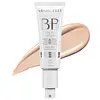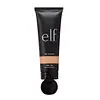What's inside
What's inside
 Key Ingredients
Key Ingredients

 Benefits
Benefits

 Concerns
Concerns

 Ingredients Side-by-side
Ingredients Side-by-side

Water
Skin ConditioningCyclopentasiloxane
EmollientOctyldodecanol
EmollientGlycerin
HumectantDimethicone/Vinyl Dimethicone Crosspolymer
Skin ConditioningDimethicone
EmollientCyclohexasiloxane
EmollientPropylene Glycol
HumectantIsopropyl Myristate
EmollientBis-PEG/PPG-14/14 Dimethicone
EmollientMica
Cosmetic ColorantAluminum Starch Octenylsuccinate
AbsorbentHexyl Laurate
EmollientCetyl PEG/PPG-10/1 Dimethicone
EmulsifyingPolyglyceryl-4 Isostearate
EmulsifyingSilica
AbrasiveXylitylglucoside
HumectantDimethicone Crosspolymer
Emulsion StabilisingSodium Chloride
MaskingAnhydroxylitol
HumectantDisteardimonium Hectorite
StabilisingIsododecane
EmollientXylitol
HumectantTrihydroxystearin
Skin ConditioningAcrylates/Dimethicone Copolymer
Skin ConditioningPropylene Carbonate
SolventTocopheryl Acetate
AntioxidantHydrolyzed Hyaluronic Acid
HumectantButylene Glycol
HumectantTriethoxycaprylylsilane
Camellia Oleifera Leaf Extract
AstringentLauroyl Lysine
Skin ConditioningAloe Barbadensis Leaf Juice
Skin ConditioningChlorphenesin
AntimicrobialIsoceteth-10
EmulsifyingGlucose
HumectantMyristic Acid
CleansingCitric Acid
BufferingPotassium Sorbate
PreservativePhenoxyethanol
PreservativeSodium Benzoate
MaskingCI 77891
Cosmetic ColorantCI 77492
Cosmetic ColorantCI 77491
Cosmetic ColorantCI 77499
Cosmetic ColorantWater, Cyclopentasiloxane, Octyldodecanol, Glycerin, Dimethicone/Vinyl Dimethicone Crosspolymer, Dimethicone, Cyclohexasiloxane, Propylene Glycol, Isopropyl Myristate, Bis-PEG/PPG-14/14 Dimethicone, Mica, Aluminum Starch Octenylsuccinate, Hexyl Laurate, Cetyl PEG/PPG-10/1 Dimethicone, Polyglyceryl-4 Isostearate, Silica, Xylitylglucoside, Dimethicone Crosspolymer, Sodium Chloride, Anhydroxylitol, Disteardimonium Hectorite, Isododecane, Xylitol, Trihydroxystearin, Acrylates/Dimethicone Copolymer, Propylene Carbonate, Tocopheryl Acetate, Hydrolyzed Hyaluronic Acid, Butylene Glycol, Triethoxycaprylylsilane, Camellia Oleifera Leaf Extract, Lauroyl Lysine, Aloe Barbadensis Leaf Juice, Chlorphenesin, Isoceteth-10, Glucose, Myristic Acid, Citric Acid, Potassium Sorbate, Phenoxyethanol, Sodium Benzoate, CI 77891, CI 77492, CI 77491, CI 77499
Water
Skin ConditioningGlycerin
HumectantPropylene Glycol
HumectantC12-15 Alkyl Benzoate
AntimicrobialTitanium Dioxide
Cosmetic ColorantCetyl PEG/PPG-10/1 Dimethicone
EmulsifyingCyclohexasiloxane
EmollientCyclopentasiloxane
EmollientSorbitan Olivate
EmulsifyingPolymethyl Methacrylate
Sodium Chloride
MaskingQuaternium-18 Bentonite
Triethoxycaprylylsilane
Dimethicone
EmollientZinc Stearate
Cosmetic ColorantTalc
AbrasiveVp/Hexadecene Copolymer
Bisabolol
MaskingTocopheryl Acetate
AntioxidantSimmondsia Chinensis Seed Oil
EmollientAloe Barbadensis Leaf Extract
EmollientCucumis Sativus Fruit Extract
EmollientMica
Cosmetic ColorantSilica
AbrasivePhenoxyethanol
PreservativeEthylhexylglycerin
Skin ConditioningMethylisothiazolinone
PreservativeParfum
MaskingCI 77491
Cosmetic ColorantCI 77492
Cosmetic ColorantCI 77499
Cosmetic ColorantEthylhexyl Methoxycinnamate 7.5%
UV AbsorberBenzophenone-3 4%
UV AbsorberEthylhexyl Salicylate 5%
UV AbsorberWater, Glycerin, Propylene Glycol, C12-15 Alkyl Benzoate, Titanium Dioxide, Cetyl PEG/PPG-10/1 Dimethicone, Cyclohexasiloxane, Cyclopentasiloxane, Sorbitan Olivate, Polymethyl Methacrylate, Sodium Chloride, Quaternium-18 Bentonite, Triethoxycaprylylsilane, Dimethicone, Zinc Stearate, Talc, Vp/Hexadecene Copolymer, Bisabolol, Tocopheryl Acetate, Simmondsia Chinensis Seed Oil, Aloe Barbadensis Leaf Extract, Cucumis Sativus Fruit Extract, Mica, Silica, Phenoxyethanol, Ethylhexylglycerin, Methylisothiazolinone, Parfum, CI 77491, CI 77492, CI 77499, Ethylhexyl Methoxycinnamate 7.5%, Benzophenone-3 4%, Ethylhexyl Salicylate 5%
Ingredients Explained
These ingredients are found in both products.
Ingredients higher up in an ingredient list are typically present in a larger amount.
This ingredient is a high molecular weight silicone. It has emulsifying and skin conditioning properties.
Ci 77491 is also hydrated iron III oxide. It's sole purpose is to give a red/pink hue to products.
Iron III oxides are classified as inorganic chemicals for coloring.
Synthetically created Ci 77491 is considered safer than those naturally found. This is because the synthetically created version may contain less impurities. Iron oxides are generally non-toxic and non-allergenic.
Learn more about CI 77491Ci 77492 is also hydrated iron III oxide. It's sole purpose is to give a yellow hue to products.
Iron III oxides are classified as inorganic chemicals for coloring.
Synthetically created Ci 77492 is considered safer than those naturally found. This is because the synthetically created version may contain less impurities. Iron oxides are generally non-toxic and non-allergenic.
Learn more about CI 77492Ci 77499 is also hydrated iron III oxide. It is created from mixing red and black iron oxides. This helps give shades of darkness to a product.
Iron III oxides are classified as inorganic chemicals for coloring.
Cyclohexasiloxane is a type of silicone more commonly known as D6. It is an emollient and solvent.
Cyclohexasiloxane is used to evenly distribute ingredients throughout the product. When applied to the skin, Cyclohexasiloxane evaporates and leaves behind a silky feel.
As an emollient, it can help the skin feel soft and hydrated. It is also used to reduce frizz in hair products.
Learn more about CyclohexasiloxaneCyclopentasiloxane, or D5, is a silicone used to improve texture of products and trap moisture.
D5 is considered lightweight and volatile. Volatile means it evaporates quickly after application. Once evaporated, D5 leaves a thin barrier that helps keep skin hydrated.
It is also an emollient. Emollients help soften the skin and prevent water loss. Silicones create a silky texture in products. D5 helps other ingredients become more spreadable.
Studies show D5 is safe to use in skincare products. We recommend speaking with a skincare professional if you have concerns.
Learn more about CyclopentasiloxaneDimethicone is a type of synthetic silicone created from natural materials such as quartz.
What it does:
Dimethicone comes in different viscosities:
Depending on the viscosity, dimethicone has different properties.
Ingredients lists don't always show which type is used, so we recommend reaching out to the brand if you have questions about the viscosity.
This ingredient is unlikely to cause irritation because it does not get absorbed into skin. However, people with silicone allergies should be careful about using this ingredient.
Note: Dimethicone may contribute to pilling. This is because it is not oil or water soluble, so pilling may occur when layered with products. When mixed with heavy oils in a formula, the outcome is also quite greasy.
Learn more about DimethiconeGlycerin is already naturally found in your skin. It helps moisturize and protect your skin.
A study from 2016 found glycerin to be more effective as a humectant than AHAs and hyaluronic acid.
As a humectant, it helps the skin stay hydrated by pulling moisture to your skin. The low molecular weight of glycerin allows it to pull moisture into the deeper layers of your skin.
Hydrated skin improves your skin barrier; Your skin barrier helps protect against irritants and bacteria.
Glycerin has also been found to have antimicrobial and antiviral properties. Due to these properties, glycerin is often used in wound and burn treatments.
In cosmetics, glycerin is usually derived from plants such as soybean or palm. However, it can also be sourced from animals, such as tallow or animal fat.
This ingredient is organic, colorless, odorless, and non-toxic.
Glycerin is the name for this ingredient in American English. British English uses Glycerol/Glycerine.
Learn more about GlycerinMica is a naturally occurring mineral used to add shimmer and color in cosmetics. It can also help improve the texture of a product or give it an opaque, white/silver color.
Serecite is the name for very fine but ragged grains of mica.
This ingredient is often coated with metal oxides like titanium dioxide. Trace amounts of heavy metals may be found in mica, but these metals are not harmful in our personal products.
Mica has been used since prehistoric times throughout the world. Ancient Egyptian, Indian, Greek, Roman, Aztec, and Chinese civilizations have used mica.
Learn more about MicaPhenoxyethanol is a preservative that has germicide, antimicrobial, and aromatic properties. Studies show that phenoxyethanol can prevent microbial growth. By itself, it has a scent that is similar to that of a rose.
It's often used in formulations along with Caprylyl Glycol to preserve the shelf life of products.
Propylene Glycol is an odorless, colorless liquid. As a humectant, it helps skin retain moisture. It also aids in delivering active ingredients.
Another role of this ingredient is preventing a product from melting or freezing. Propylene glycol also adds antimicrobrial properties to a product, elongating product lifespan.
This ingredient is considered an organic alcohol and commonly added into both cosmetics and foods.
Those with sensitive skin or conditions may develop a rash when using this ingredient.
Learn more about Propylene GlycolSilica, also known as silicon dioxide, is a naturally occurring mineral. It is used as a fine, spherical, and porous powder in cosmetics.
Though it has exfoliant properties, the function of silica varies depending on the product.
The unique structure of silica enhances the spreadability and adds smoothness, making it a great texture enhancer.
It is also used as an active carrier, emulsifier, and mattifier due to its ability to absorb excess oil.
In some products, tiny microneedles called spicules are made from silica or hydrolyzed sponge. When you rub them in, they lightly polish away dead skin layers and enhance the penetration of active ingredients.
Learn more about SilicaChances are, you eat sodium chloride every day. Sodium Chloride is also known as table salt.
This ingredient has many purposes in skincare: thickener, emulsifier, and exfoliator.
You'll most likely find this ingredient in cleansers where it is used to create a gel-like texture. As an emulsifier, it also prevents ingredients from separating.
There is much debate on whether this ingredient is comedogenic. The short answer - comedogenic ratings don't tell the whole story. Learn more about comegodenic ratings here.
The concensus about this ingredient causing acne seems to be divided. Research is needed to understand if this ingredient does cause acne.
Scrubs may use salt as the primary exfoliating ingredient.
Learn more about Sodium ChlorideTocopheryl Acetate is AKA Vitamin E. It is an antioxidant and protects your skin from free radicals. Free radicals damage the skin by breaking down collagen.
One study found using Tocopheryl Acetate with Vitamin C decreased the number of sunburned cells.
Tocopheryl Acetate is commonly found in both skincare and dietary supplements.
Learn more about Tocopheryl AcetateTriethoxycaprylylsilane is a silicone used to bind and stabilize ingredients.
As an emulsifier, it helps prevent ingredients from separating. This can help elongate the shelf life of products.
Triethoxycaprylylsilane is often used to coat mineral sunscreens ingredients to help give a better feel. It also helps reduce oxidative stress in sunscreens.
Learn more about TriethoxycaprylylsilaneWater. It's the most common cosmetic ingredient of all. You'll usually see it at the top of ingredient lists, meaning that it makes up the largest part of the product.
So why is it so popular? Water most often acts as a solvent - this means that it helps dissolve other ingredients into the formulation.
You'll also recognize water as that liquid we all need to stay alive. If you see this, drink a glass of water. Stay hydrated!
Learn more about Water